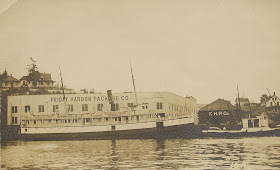 |
| Photo postcard by Johnston, postmarked 1948. From the archives of the S.P.H.S. © |
"If only docks could talk, oh what stories they could tell! For many years my Uncle Art was the engineer on the Friday Harbor Canning Co.'s fish carrier NEREID. Of course, when they came in with a load of salmon they needed to tie up at the cannery dock to unload, but other times they just needed a place to park the boat for awhile. In such a case, if all of the spaces were full, they often tied up to another boat that was already at the dock. (This practice is called rafting.)
Way back in the thirties or forties, Uncle Art was a good friend of George Willey who was the manager of the Friday Harbor Canning Co. It seems that one summer, someone with a log patrol license had tied a cedar log alongside the cannery dock. It was a big one, probably in access of six-feet in diameter and about forty-feet long. They left it there for a long time; so long in fact that Mr. Willey was getting worried that a big winter northeaster would drive it right through the cannery dock. He told Uncle Art about his concerns and asked 'Unk' if he could do anything about the situation.
Well, one very foggy day someone untied the big log and gave it a mighty push out into that dense fog. Dad 'just happened' to be out in that fog with his boat, and slowly the huge shape of that log came into sight. Dad said that in that thick fog it looked like it was as big as an aircraft carrier. He towed it home and cut it into shake bolts. Quickly he moved those bolts to a nice secluded clearing in the trees where he split them into shakes. There were enough to shake the entire house with a lot left over. As a teenager, I planed some of those leftover shakes to about an eighth of an inch thickness and made them into a guitar. Some sixty years later I still have that guitar. The cedar wood was beautiful in the guitar; the shakes were beautiful on the house too. They're still on the old house today."
Above text by Henry Hoffman, San Juan County, Oct. 2006
Henry's Stories, Kitchen Garden Press, Shaw Island, 2008.
|
Soon after the turn of the century, together with the late Wm. Schultz and Wm. Persell, he formed the Friday Harbor Packing Co. and purchased the present Friday Harbor Canning Co. property, to operate one of the most successful ventures on Puget Sound.
In 1925, on the death of Wm. Schultz, he took over the cannery and continued as principal owner and manager until 1935, when he retired.
Courtesy of the Friday Harbor Journal, n.d.





